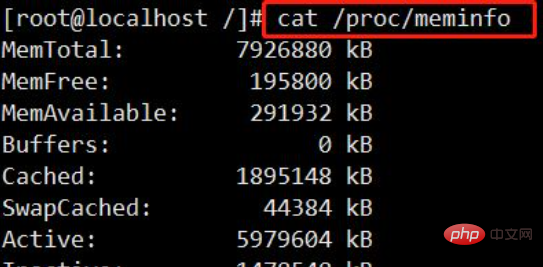 Operation and Maintenance
Operation and Maintenance
 Linux Operation and Maintenance
Linux Operation and Maintenance
 What is the command to check the memory size in Linux?
What is the command to check the memory size in Linux?
What is the command to check the memory size in Linux?
Linux command to check the memory size: 1. The free command is used to display the system memory status. Just execute "free -m". The value of the "total" item in the output list is the total amount of memory queried; 2. The "cat /proc/meminfo" command is used to read and display the contents of the "/proc/meminfo" file. It can display detailed memory information. The value of the "MemTotal" item in the output list is the total memory size queried.

#The operating environment of this tutorial: linux7.3 system, Dell G3 computer.
Linux commands to check the memory size: free command and cat /proc/meminfo command.
free command
The free command is used to display the system memory status, including system physical memory and virtual memory (swap swap partition) , shared memory and system cache usage, the output is very similar to the memory part of the top command.
The basic format of the free command is as follows:
[root@localhost ~]# free [选项]
Table 1 lists the commonly used options of this command and their respective meanings.
| Options | Meaning |
| Displays memory usage in Byte (byte). | |
| Displays memory usage in KB. This option is the default option of the free command. | |
| Displays memory usage in MB. | |
| Displays memory usage in GB. | |
| In the final result of the output, output the total amount of memory and swap partition. | |
| Do not display the system buffer column. | |
| Continue to display memory usage according to the specified interval. |
free Check the memory size--Execute free -m
free -m Display memory usage in MB.

free -m In the command output list, the first line displays the list header information of each column, and their respective meanings are as follows:
- total is the total amount of memory;
- used is the amount of memory that has been used;
- free is the number of free memory;
- shared is the total amount of memory shared by multiple processes;
- buffers is the number of buffer memory;
- cached is the amount of cache memory.
cat /proc/meminfo command
File is the main interface to understand the memory usage of Linux system. Our most commonly used "free", "vmstat" and other commands are to obtain data through it. The information contained in /proc/meminfo is better than " free" and other commands are much richer.
View the detailed information of the Linux system memory size, you can view the total memory, remaining memory, available memory and other information.
 Related recommendations: "
Related recommendations: "
The above is the detailed content of What is the command to check the memory size in Linux?. For more information, please follow other related articles on the PHP Chinese website!

Hot AI Tools

Undresser.AI Undress
AI-powered app for creating realistic nude photos

AI Clothes Remover
Online AI tool for removing clothes from photos.

Undress AI Tool
Undress images for free

Clothoff.io
AI clothes remover

Video Face Swap
Swap faces in any video effortlessly with our completely free AI face swap tool!

Hot Article

Hot Tools

Notepad++7.3.1
Easy-to-use and free code editor

SublimeText3 Chinese version
Chinese version, very easy to use

Zend Studio 13.0.1
Powerful PHP integrated development environment

Dreamweaver CS6
Visual web development tools

SublimeText3 Mac version
God-level code editing software (SublimeText3)

Hot Topics
 1663
1663
 14
14
 1420
1420
 52
52
 1313
1313
 25
25
 1266
1266
 29
29
 1238
1238
 24
24
 Linux Architecture: Unveiling the 5 Basic Components
Apr 20, 2025 am 12:04 AM
Linux Architecture: Unveiling the 5 Basic Components
Apr 20, 2025 am 12:04 AM
The five basic components of the Linux system are: 1. Kernel, 2. System library, 3. System utilities, 4. Graphical user interface, 5. Applications. The kernel manages hardware resources, the system library provides precompiled functions, system utilities are used for system management, the GUI provides visual interaction, and applications use these components to implement functions.
 How to check the warehouse address of git
Apr 17, 2025 pm 01:54 PM
How to check the warehouse address of git
Apr 17, 2025 pm 01:54 PM
To view the Git repository address, perform the following steps: 1. Open the command line and navigate to the repository directory; 2. Run the "git remote -v" command; 3. View the repository name in the output and its corresponding address.
 vscode Previous Next Shortcut Key
Apr 15, 2025 pm 10:51 PM
vscode Previous Next Shortcut Key
Apr 15, 2025 pm 10:51 PM
VS Code One-step/Next step shortcut key usage: One-step (backward): Windows/Linux: Ctrl ←; macOS: Cmd ←Next step (forward): Windows/Linux: Ctrl →; macOS: Cmd →
 What is the main purpose of Linux?
Apr 16, 2025 am 12:19 AM
What is the main purpose of Linux?
Apr 16, 2025 am 12:19 AM
The main uses of Linux include: 1. Server operating system, 2. Embedded system, 3. Desktop operating system, 4. Development and testing environment. Linux excels in these areas, providing stability, security and efficient development tools.
 How to run java code in notepad
Apr 16, 2025 pm 07:39 PM
How to run java code in notepad
Apr 16, 2025 pm 07:39 PM
Although Notepad cannot run Java code directly, it can be achieved by using other tools: using the command line compiler (javac) to generate a bytecode file (filename.class). Use the Java interpreter (java) to interpret bytecode, execute the code, and output the result.
 How to run sublime after writing the code
Apr 16, 2025 am 08:51 AM
How to run sublime after writing the code
Apr 16, 2025 am 08:51 AM
There are six ways to run code in Sublime: through hotkeys, menus, build systems, command lines, set default build systems, and custom build commands, and run individual files/projects by right-clicking on projects/files. The build system availability depends on the installation of Sublime Text.
 laravel installation code
Apr 18, 2025 pm 12:30 PM
laravel installation code
Apr 18, 2025 pm 12:30 PM
To install Laravel, follow these steps in sequence: Install Composer (for macOS/Linux and Windows) Install Laravel Installer Create a new project Start Service Access Application (URL: http://127.0.0.1:8000) Set up the database connection (if required)
 git software installation
Apr 17, 2025 am 11:57 AM
git software installation
Apr 17, 2025 am 11:57 AM
Installing Git software includes the following steps: Download the installation package and run the installation package to verify the installation configuration Git installation Git Bash (Windows only)



